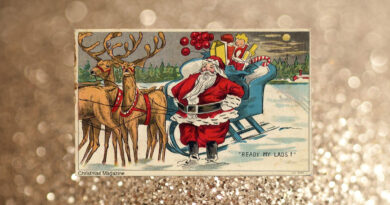The Snowdrop
Hans Christian Andersen (1805-1875)
It was wintertime; the air was cold, the wind sharp, but indoors all was snug and well. Indoors lay the flower; it lay in its bulb, under earth and snow.
One day the rain fell; the drops trickled down through the snow blanket, down into the earth, and stirred against the bulb, telling it of the world of light up above. Soon a sunbeam, so slender and penetrating, bored through the snow, down to the bulb, and tapped on it.
“Come in,” said the Flower.
“That I can’t do,” said the Sunbeam. “I’m not strong enough to open you up. I shall be very strong by summer.”
“When will it be summer?” asked the Flower, and repeated this every time a new sunbeam came down to it. But summer was far off; snow remained on the earth, and ice formed on the water in the streams every blessed night.
“How long this lasts! How long this lasts!” said the Flower. “I feel a tingling and tickling. I must stretch myself; I must extend myself. I must open up; I must come out and wave good morning to the summer; that will be a wonderful time!”
And the Flower stretched itself and extended itself against the thin shell that had been softened by the rain water, warmed by the blanket of earth and snow, and tapped upon by the Sunbeam. It burst forth beneath the snow, with a white and green bud on its green stalk, with narrow, thick leaves, curled around it as if for protection. The snow was cold, but light radiated down into it, making it quite easy to break through; and here now the Sunbeam streamed down with greater strength than before.
“Welcome! Welcome!” sang and rang out every sunbeam as the Flower rose above the snow, out into the world of light. The Sunbeams caressed and kissed it, so that it opened itself fully, white as snow and adorned with green stripes. It bowed its head in happiness and humility.
“Beautiful flower!” sang the Sunbeams. “How fresh and pure you are! You are the first; you are the only one! You are our love! You ring out the call of summer, lovely summer, over town and country! All the snow shall melt, the cold winds be driven away! We shall reign! Everything shall grow green! And then you shall have company, the lilacs and laburnums and finally the roses. But you are the first, so tender and pure!”
This was a great delight to the Flower. It was as if the air itself were ringing and singing, as if the Sunbeams were all penetrating the leaves and stem of the Flower. There it stood, so fine and fragile, and yet so strong, in all its youthful beauty, in its white kirtle with the green bands, praising the summer. But summertime was far off; clouds shrouded the sun; sharp winds blew on the Flower.
“You have come a little too early!” said Wind and Weather. “We still have power, and this you shall feel and have to comply with! You should have remained indoors, instead of rushing out here to display your finery! It is not the time for that yet!”
It was bitingly cold, and the days that followed didn’t bring a sunbeam. It was weather to freeze such a delicate little flower to bits. But there was more strength in it than even it realized. That strength was in its happy faith that summer must come, and this had been imparted by its own deep desire and confirmed by the warm sunlight. And so with patient hope it stood there in its white dress, in the white snow, bowing its head when the snowflakes fell thick and heavy or while the icy winds swept over it.
“You’ll break!” they said. “Wither, freeze! What did you want out here? Why did you let yourself be enticed? The Sunbeam has hoaxed you! Now make the best of it, you snowdrop, summer fool!”
“Snowdrop, summer fool!” repeated the Flower there in the cold morning.
“Snowdrop!” rejoiced some children who came into the garden. “There stands one, so sweet, so beautiful-the first, the only one!
And these words made the Flower feel so well; they were like the warm Sunbeams. In its gladness it never noticed that it was being plucked. Then it lay in a child’s hand, was kissed by a child’s lips, brought into a warm room, gazed upon by kindly eyes, and set in water-so strengthening, so exhilarating. The Flower thought that it had all of a sudden come into midsummer.
The daughter of the house was a lovely little girl who had just been confirmed. And she had a dear boy friend; he also had been confirmed, and was studying to equip himself for earning a living. “He shall be my snowdrop!” she told herself. Then she took the lovely Flower and laid it on a scented piece of paper that had a verse written on it, a verse about the Flower, beginning with “snowdrop” and ending with “snowdrop.” “Little sweetheart, be my snowdrop, my winter fool!”-thus she had playfully mocked him with the summer. Yes, that was written in the verses. And it was then folded up like a letter, with the Flower placed inside; it was dark in there where it lay, as dark as when it had been in the bulb. The Flower was sent on a journey; it lay in a mail sack, was pressed and squeezed, and that was not at all pleasant, but finally this came to an end.
When the journey was over, the letter was opened and read by her dear friend. He was so delighted that he kissed the Flower. And then it was locked up, with the poem around it, in a drawer where there lay many charming letters, though none had a flower in it. Here, too, it was the first, the only one, as the Sunbeams had called it, and that was pleasant to think about.
It had a long period of leisure in which to think about it; it thought while the summer passed, and the long winter passed, and then when it was summer again, it was brought forth from the drawer. But this time the young man was not at all happy. He seized up the letters very harshly, and flung away the poem, so that the Flower fell onto the floor. It had become flattened and withered, but that was no reason to throw it onto the floor, though it was better off lying there than in the fire, where poems and letters were blazing. What had happened? What so often happens. The Flower had mocked him, and that was a joke; the girl had mocked him, but that was no joke; she had chosen another boy friend this midsummer.
In the morning the sun shone in on the little flattened Snowdrop, which looked as if it were painted on the floor. The maid who swept the room picked it up and placed it in one of the books on the table, for she thought it had fallen out when she was clearing up and putting things in order. And so once again the Flower lay between verses, printed verses this time, which are grander than the written ones-at least they cost more.
Years passed, throughout which the book stood on its shelf. But now at last it was taken down, opened, and read. It was a good book-the songs and poems of the Danish poet, Ambrosius Stub, who is well worth your knowing. The man who was reading the book turned a page.
“Ah, here is a flower!” he said. “A snowdrop! It is with significance indeed that it lies here. Poor Ambrosius Stub! He was a snowdrop, too, a poet-snowdrop. He was before his time, and therefore he had to face sharp winds and sleet as he passed among the gentlemen of Funen; he was like a flower in a water glass, a flower in a valentine; a summer fool, winter fool, full of fun and drollery. And yet he was the first, the only youthfully fresh Danish poet. Yes, lie there as a marker in this book, little Snowdrop. You are laid here with meaning!”
And then the Snowdrop again was placed in the book, and felt both honored and delighted to know that it was a marker in the beautiful book of poetry, and that he who had first written and sung about the flower had also been a snowdrop and been mocked in the winter. Now the Flower understood this in its own way, just as we understand things in our way.
That is the fairy story of the Snowdrop.


